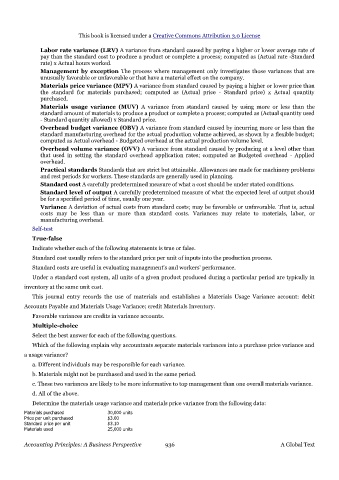Page 935 - Accounting Principles (A Business Perspective)
P. 935
This book is licensed under a Creative Commons Attribution 3.0 License
Labor rate variance (LRV) A variance from standard caused by paying a higher or lower average rate of
pay than the standard cost to produce a product or complete a process; computed as (Actual rate -Standard
rate) x Actual hours worked.
Management by exception The process where management only investigates those variances that are
unusually favorable or unfavorable or that have a material effect on the company.
Materials price variance (MPV) A variance from standard caused by paying a higher or lower price than
the standard for materials purchased; computed as (Actual price - Standard price) x Actual quantity
purchased.
Materials usage variance (MUV) A variance from standard caused by using more or less than the
standard amount of materials to produce a product or complete a process; computed as (Actual quantity used
- Standard quantity allowed) x Standard price.
Overhead budget variance (OBV) A variance from standard caused by incurring more or less than the
standard manufacturing overhead for the actual production volume achieved, as shown by a flexible budget;
computed as Actual overhead - Budgeted overhead at the actual production volume level.
Overhead volume variance (OVV) A variance from standard caused by producing at a level other than
that used in setting the standard overhead application rates; computed as Budgeted overhead - Applied
overhead.
Practical standards Standards that are strict but attainable. Allowances are made for machinery problems
and rest periods for workers. These standards are generally used in planning.
Standard cost A carefully predetermined measure of what a cost should be under stated conditions.
Standard level of output A carefully predetermined measure of what the expected level of output should
be for a specified period of time, usually one year.
Variance A deviation of actual costs from standard costs; may be favorable or unfavorable. That is, actual
costs may be less than or more than standard costs. Variances may relate to materials, labor, or
manufacturing overhead.
Self-test
True-false
Indicate whether each of the following statements is true or false.
Standard cost usually refers to the standard price per unit of inputs into the production process.
Standard costs are useful in evaluating management's and workers' performance.
Under a standard cost system, all units of a given product produced during a particular period are typically in
inventory at the same unit cost.
This journal entry records the use of materials and establishes a Materials Usage Variance account: debit
Accounts Payable and Materials Usage Variance; credit Materials Inventory.
Favorable variances are credits in variance accounts.
Multiple-choice
Select the best answer for each of the following questions.
Which of the following explain why accountants separate materials variances into a purchase price variance and
a usage variance?
a. Different individuals may be responsible for each variance.
b. Materials might not be purchased and used in the same period.
c. These two variances are likely to be more informative to top management than one overall materials variance.
d. All of the above.
Determine the materials usage variance and materials price variance from the following data:
Materials purchased 30,000 units
Price per unit purchased $3.00
Standard price per unit $3.10
Materials used 25,000 units
Accounting Principles: A Business Perspective 936 A Global Text

